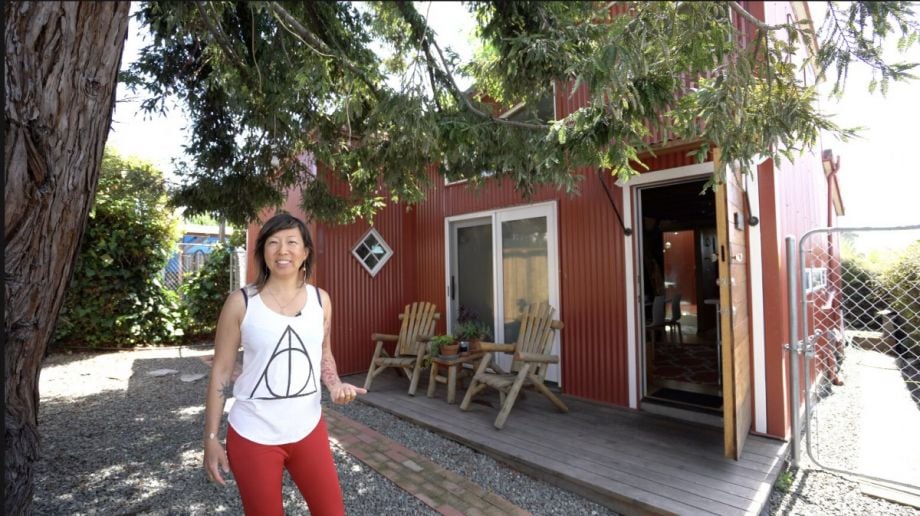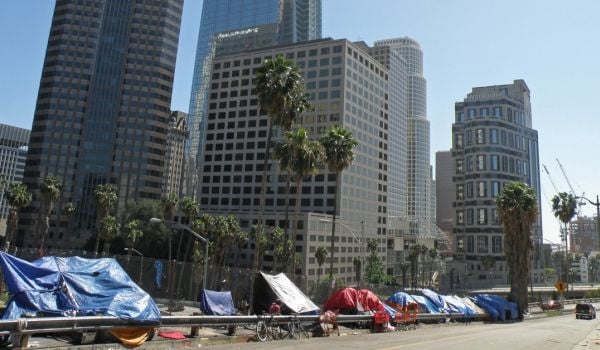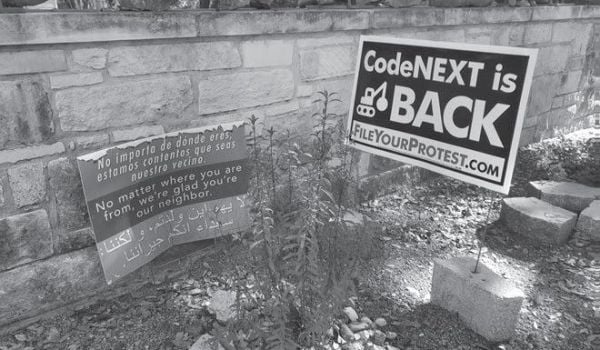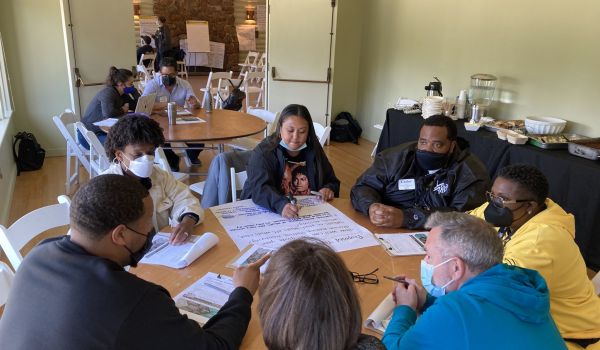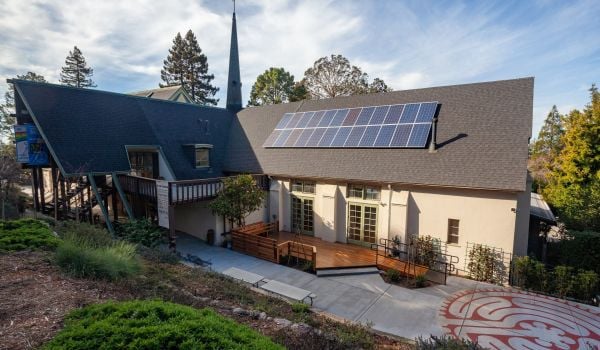Braunz Courtney is no stranger to real estate. The Oakland resident and realtor bought a house on 57th Avenue in East Oakland back in 2015. After significant financial investment, upgrading the property with new appliances, adding another bathroom, and building a detached 500-square-foot cottage — or accessory dwelling unit (ADU) — on the property, he had it appraised in 2019. He was surprised to find it valued at far less than he expected.
“It raised a lot of alarms for me,” says Courtney. “The math was not adding up.” Comparable homes in other (and whiter) Oakland neighborhoods were appraised at about $100K to $150K higher than his property.
“It was discrimination. Plain and simple,” he says. Courtney fired that broker and hired a new one, who confirmed Courtney’s instincts. The math did not add up, and his home was worth a lot more than the initial appraisal.
His story made local headlines in 2021, first reported by race and justice reporter Julian Glover of ABC7 news. Courtney was one of many homeowners in the Bay Area who have pointed out the modern-day redlining practices, in which homes owned by Black and Brown people, or that are in historically redlined neighborhoods, are valued less.
While it was clear to Courtney that even deeply rooted and knowledgeable BIPOC homeowners like himself are still discriminated against, this anecdote surfaces another insidious legacy of structurally racist real-estate practices in communities of color: lack of basic education about what it means to own property.
“People don’t know what’s legal, what’s not,” he said. “Some people just don’t know what they’re sitting on because no one taught them. They don’t know how to be landlords. They don’t know how to look for contractors. If they should rent their ADU or put it up as Airbnb.”
That’s where Keys to Equity comes in — a program launched in October 2021 to eliminate some of those educational and financial barriers, specifically among Black homeowners. Keys to Equity is a collaboration with Richmond Neighborhood Housing Service (RNHS), the Center for Community Self-Help (Self-Help), The WellNest Company, the Chan Zuckerberg Initiative (CZI), the City of Oakland, and the San Francisco Foundation (SFF).
While there are many benefits to building an ADU, BIPOC homeowners are less likely to reap those benefits. A report out this month from UC Berkeley’s Terner Center for Housing Innovation surveyed 32 BIPOC homeowners and found that the process from start (securing the funds to build) to finish (becoming a landlord) is significantly more difficult and daunting for homeowners of color than it is for white homeowners, in large part because of a lack of regulatory oversight from cities who are just now implementing ordinances around ADUs.
According to the report, “Other interventions may be needed to close the capital and information gaps that are keeping lower income and households of color from building ADUs. In particular, sources of finance and technical assistance are needed, and local governments must begin to simplify and lower the cost of obtaining an ADU permit so that permitting itself does not remain a barrier to equitable ADU adoption.”
In Oakland and other California cities, more ADUs are showing up in garage conversions, in-law suites and backyard cottages because of two pieces of state legislation intended to streamline the process. AB-881 eliminated the requirement that homeowners must occupy their property where an ADU is constructed. AB-68 did many things, but essentially granted the power of local authorities to create ordinances around the construction of ADUs, solidifying the process within their own jurisdictions. Both became law in 2020.
The creation of RNHS, the nonprofit that manages Keys to Equity, in 1981, coincided with a point in time when 18.5% of Oakland residents lived below the federal poverty level, according to census records from the Bay Area. The service was created to address the housing needs of the East Bay’s lowest-income residents.
The same census records show that from 1980 through 1990, Oakland had a majority of Black residents. From 1970 through 1990, the Latino and Hispanic population was growing rapidly, adding well over 10,000 people over the course of each decade.
After Keys to Equity launched last fall, word spread about the program through the local press, through city government connections and by word of mouth among organizations already trusted and established within Oakland’s Black communities. Out of 138 applicants, 70 homeowners were chosen for the initial cohort and are continuing consultation with the program.
Keys to Equity will lead this cohort through the entire process of building new ADUs. Each cohort member will receive one-on-one consultation. First, each homeowner will receive guidance on what financial product best suits their needs from Self-Help Federal Credit Union, the program’s financing partner. Next is the design and construction, with WellNest, another trusted Oakland institution that serves as the general contractor for the program. In the end, Keys to Equity will lead ADU owners in a crash course on how to be a landlord (if they choose to rent out the unit they’ve built).
“We really wanted to make it a journey, from financing to learning to become a landlord,” says Nikki Beasley, the executive director of Richmond Neighborhood Housing Services.
None of the applicants have broken ground on an ADU yet, but in Beasley’s eyes, the program is going well. One aspect of the program that surprised her is how much interest there was in just learning about the ADU process. “People really wanted information first. We didn’t know how much of a value-add the education was going to be for people who weren’t quite set on a decision,” she says.
Though the program is still in its initial iteration, they hope to eventually expand into a related area: working with homeowners to rehab existing ADUs that aren’t up to building codes.
In a 2020 review of ADU accessibility, the City of Oakland estimated that out of the homes included in their sample that were likely to have an ADU, 91% had been constructed without a permit. More than half of the ADUs were also attached to the home, chiefly a conversion of a garage or basement.
Julia Greenberg, one of the authors of the Terner Center report, found that many cities like Oakland, with densely populated neighborhoods of color, have used ADUs as a way to accommodate multigenerational households or earn extra income. “But there’s a lot of fear around the permit process,” Greenberg says. “[Homeowners are] afraid code enforcement will come in and shut things down.”
Oakland has implemented an amnesty program for ADUs built without prior building permits, which allows a grace period to get those dwellings up to code. Existing ADU owners can download the five-page application on the city’s ADU resource page.
Already owning an unpermitted or not-to-code ADU is one problem. But finding the money to fund an ADU is another hurdle to clear. Greenberg and her team found that the majority of homeowners of color do not have access to the same financial options as their white counterparts. (ADUs typically cost $250 per square foot just to construct.)
Oakland’s ADU review team reached a similar conclusion and wrote in their report that the financial market for ADUs is very much in the “start-up” phase. In other words, apart from the few credit unions that pay attention to local laws, bigger banks haven’t exactly caught on. “Banks don’t usually think about the future revenue a single-family property can bring in, so there are very few [loan or financing products] on the market,” says Greenberg.
The city’s own analysis, the experience of Oakland residents, and the findings of researchers all point to the same conclusion. Breaking down barriers to equitable access to ADUs will require a multipronged approach, not only to streamline regulations but also to undo the legacy of gatekeeping knowledge.
“City leaders, specifically those loudest within our Black community, need to teach and invest in [their] homebuyers. They need to know what they can sit on, when to sell, and show them what assets they have,” says Courtney. “We need more programs, more supervisors, identifying these gaps and educating people.”
This article is part of Backyard, a newsletter exploring scalable solutions to make housing fairer, more affordable and more environmentally sustainable. Subscribe to our weekly Backyard newsletter.
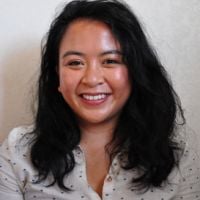
Marielle Argueza is Next City’s Equitable Cities Reporting Fellow for Racial Justice Narratives in partnership with Triad City Beat in Greensboro, North Carolina. Formerly Next City's INN/Columbia Journalism School intern for Summer-Fall 2022, she’s a journalist with more than a decade of experience reporting on education, immigration, labor, criminal justice, climate and more. Her work in K-12 education is award-winning and she was recognized multiple times by the California News Publishers Association. She is a recent graduate of Columbia Journalism School, where she was Toni Stabile Investigative Fellow. Her work includes a story on Harlem’s last assisted-living facility for people living with HIV/AIDS; a profile on New York State’s first Farmers Union; and a database of deaths within the Milwaukee County Jail. She is also a recipient of other fellowships and scholarships from several notable organizations within the news industry including the Asian American Journalists Association, Association of Alternative Newsmedia, ProPublica, and the Journalism and Women Symposium.



